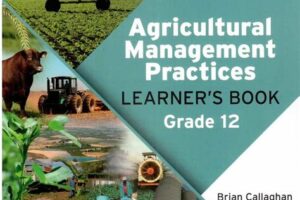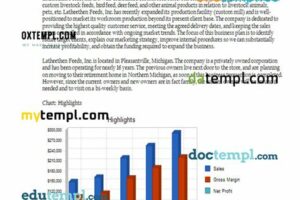Table of Contents
A farm business plan outline is a comprehensive document that outlines the goals, strategies, and financial projections for a farm business. It provides a roadmap for farmers to navigate the challenges and opportunities in the industry, covering key areas such as production, marketing, finance, and operations. This guide assists farmers in developing a clear and organized plan to maximize their chances of success in the agricultural sector.
A well-crafted farm business plan is crucial for any agricultural enterprise aiming to thrive in today’s competitive market. Not only does it serve as a roadmap for success, but it also provides a comprehensive outline of the various elements that contribute to a fruitful farming operation. Whether you’re an experienced farmer looking to expand your business or a newcomer ready to embark on your agricultural journey, this farm business plan outline will guide you through the process of developing a strategic and profitable farming enterprise.
Introduction
A farm business plan is an essential tool for any farmer or agricultural entrepreneur looking to start or expand their farming operation. It serves as a roadmap, outlining the goals, strategies, and financial projections of the business. A well-crafted farm business plan provides a solid foundation for success and helps secure funding from investors or lenders. In this article, we will outline the key components of a comprehensive farm business plan.
Executive Summary
The executive summary is a concise overview of the entire farm business plan. It provides a brief description of the farm, its mission statement, products or services offered, target market, and financial projections. The executive summary should be compelling and highlight the unique selling points of the farm.
Company Description
In this section, provide a detailed description of your farm business. Include information such as the legal structure of the farm (sole proprietorship, partnership, corporation), location, size, history, and ownership details. Highlight your competitive advantages and any unique aspects of your farm that set it apart from others.
Products and Services
Describe the specific products or services that your farm will offer. Include details about the crops, livestock, or value-added products you plan to produce. Explain the quality standards, certifications, or organic practices that will differentiate your products in the market. Also, mention any additional services, such as agritourism or on-farm education programs.
Market Analysis
Conduct thorough market research to understand your target audience, competitors, and industry trends. Identify your ideal customers, their needs, preferences, and purchasing behavior. Analyze the demand and supply dynamics of your products or services. Assess the competitive landscape and determine how you can position your farm to stand out.
Marketing and Sales Strategies
Outline your marketing and sales strategies to reach and attract customers. Describe the channels you will use to promote your farm, such as social media, websites, farmers’ markets, or local distributors. Explain how you will communicate your unique value proposition and build brand awareness. Develop a pricing strategy and sales forecast based on market analysis.
Management and Organization
Provide detailed information about the management structure of your farm. List the key personnel and their roles, responsibilities, and qualifications. Highlight any relevant experience or expertise that your team brings to the table. Additionally, discuss any external advisors or consultants you plan to involve in your farm’s operations.
Operations Plan
The operations plan outlines the day-to-day activities of your farm. Describe the production processes, equipment, and facilities required for your farming operation. Include information on sourcing inputs, managing inventory, and maintaining quality control. Discuss the farming techniques and practices you will employ, such as crop rotation, pest control, or animal welfare.
Financial Projections
Present a comprehensive financial analysis of your farm business. Include projected income statements, cash flow statements, and balance sheets for at least three years. Estimate your revenue based on sales projections, taking into account market demand and pricing. Outline your expenses, including costs of production, labor, marketing, and overheads. Provide details about your funding requirements and any existing or potential sources of financing.
Risk Analysis and Mitigation Strategies
Identify the potential risks and challenges that your farm may face and develop strategies to mitigate them. Discuss factors such as weather conditions, pests, diseases, market fluctuations, or regulatory changes that could impact your operations. Explain how you plan to adapt and respond to these risks, ensuring the sustainability and resilience of your farm business.
Conclusion
A well-structured farm business plan is crucial for the success of any agricultural venture. It provides a clear roadmap for achieving your farm’s goals and securing financing. By following the outline provided in this article, you can create a comprehensive and professional farm business plan that sets you up for success in the farming industry.
1. Executive Summary:
The executive summary serves as a concise overview of the farm business plan, providing a snapshot of its key elements and objectives. This section highlights the farm’s mission, vision, target market, products or services offered, and the unique value proposition that sets it apart from competitors. By presenting these essential details upfront, the executive summary allows readers to quickly grasp the purpose and potential of the farm.
2. Company Description:
The company description section provides vital background information about the farm, such as its legal structure, location, and ownership details. It also includes the farm’s long-term goals, core values, and a brief history of its establishment. By sharing these aspects, the company description helps potential investors or partners gain a deeper understanding of the farm’s history, identity, and aspirations.
3. Market Analysis:
In the market analysis segment, extensive research is conducted on the farm’s target market, including potential customers, competitors, and industry trends. This section offers insights into the demand for the farm’s products or services, market competition, and opportunities for growth. By thoroughly understanding the market, the farm can develop effective strategies for positioning itself and gaining a competitive advantage.
4. Products or Services:
This section focuses on providing a comprehensive description of the farm’s products or services. It should include detailed information about the various types of crops or livestock being produced, highlighting their quality, uniqueness, and how they meet consumers’ needs. Additionally, any value-added products or services offered by the farm, such as organic certifications, farm-to-table initiatives, or educational programs, should be discussed in this section.
5. Marketing and Sales Strategy:
In the marketing and sales strategy section, the farm outlines its approach to promoting and selling its products or services. This includes advertising and promotional strategies, distribution channels, pricing models, and customer retention tactics. The section should also touch upon the farm’s brand identity and how it plans to differentiate itself in the market, ensuring it captures and maintains a strong customer base.
6. Operational Plan:
The operational plan explains the day-to-day activities and processes involved in running the farm. It covers factors such as land acquisition, equipment and machinery requirements, labor needs, farming techniques, and supply chain management. By providing detailed information on operational aspects, this section ensures that the farm is well-prepared to execute its production and operational activities efficiently.
7. Management and Organization:
This section offers an overview of the farm’s management structure and key personnel. It outlines their roles, responsibilities, and qualifications, allowing readers to understand the expertise driving the farm’s operations. The section also highlights the farm’s organizational chart, decision-making processes, and any advisory boards or partnerships established to support its operations.
8. Financial Plan:
The financial plan details the farm’s financial forecasts, including sales projections, operating costs, budgets, and income statements. It also addresses funding requirements, outlining potential financing sources and investment opportunities. This section demonstrates the farm’s financial viability and helps potential investors or lenders gauge the returns they can expect from their involvement.
Note: While these subheadings provide a general outline for a farm business plan, it’s essential to tailor the content to the specific needs and characteristics of your farm. By customizing the plan, you can ensure that it accurately reflects your farm’s unique strengths, market conditions, and goals.
As a professional in the field of agriculture, I understand the importance of having a well-structured and comprehensive farm business plan. This document serves as a roadmap for success and helps ensure that all aspects of the farming business are thoroughly considered and planned for. Below is an outline of a farm business plan, organized into bullet points and numbered sections:
1. Executive Summary
- Provide a brief overview of the farm business, including its mission, goals, and key objectives.
- Highlight the unique selling points and competitive advantages of the farm.
2. Company Description
- Present detailed information about the farm, such as its legal structure, location, size, and history.
- Describe the farm’s products or services, target market, and target customers.
3. Market Analysis
- Analyze the current agricultural market trends, including demand, competition, and potential opportunities.
- Identify the target market segments and their specific needs and preferences.
- Conduct a SWOT analysis to evaluate the strengths, weaknesses, opportunities, and threats in the market.
4. Organization and Management
- Outline the organizational structure of the farm, including the roles and responsibilities of key team members.
- Provide information about the qualifications and experience of the management team.
5. Products and Services
- List and describe the farm’s primary products or services.
- Explain the production process, including sourcing, cultivation, harvesting, and packaging.
- Detail any additional services or value-added products that the farm offers.
6. Marketing and Sales Strategy
- Define the target market segments and outline the strategies to reach and attract customers.
- Describe the pricing strategy, distribution channels, and promotional activities.
- Explain how the farm will build and maintain customer relationships.
7. Financial Projections
- Provide a detailed analysis of the farm’s financial performance, including projected revenues, expenses, and profits.
- Include a break-even analysis, cash flow projections, and balance sheets.
- Discuss the funding requirements and potential sources of financing.
8. Risk Assessment and Mitigation
- Identify the potential risks and challenges that the farm may face.
- Develop strategies to mitigate these risks, such as diversification, insurance, or contingency plans.
9. Implementation Plan
- Outline the timeline for implementing the various aspects of the farm business plan.
- Assign responsibilities and set milestones to track progress.
In conclusion, a well-structured farm business plan is essential for any agricultural enterprise. It provides a comprehensive overview of the farm’s goals, strategies, and financial projections, helping to guide decision-making and ensure long-term success. By following this outlined structure, farmers can effectively communicate their vision, analyze the market, and create a solid plan for their farming business.
Thank you for taking the time to visit our blog and learn more about the Farm Business Plan Outline. We understand that starting or expanding a farm business can be a daunting task, and having a well-structured plan in place is crucial for success. In this article, we have provided you with an outline that will serve as a guide to help you develop a comprehensive and professional business plan.
First and foremost, it is important to recognize the significance of a well-crafted business plan. It serves as a roadmap that outlines your goals, strategies, and action steps to achieve those goals. A solid plan not only helps you stay focused on your objectives but also acts as a valuable tool when seeking financing or partnerships. With our outlined structure, you can ensure that your plan covers all the essential elements necessary for a successful farm business.
The Farm Business Plan Outline consists of several key sections that are crucial for any agricultural enterprise. These sections include the executive summary, company description, market analysis, organization and management, product line or services, marketing and sales strategy, financial projections, and implementation plan. Each section plays a vital role in presenting a comprehensive picture of your farm business to potential investors, lenders, or partners.
In conclusion, we hope that this Farm Business Plan Outline has provided you with a clear understanding of the essential components needed to create a professional and effective business plan for your farm. Remember, a well-structured plan not only helps you define your goals and strategies but also communicates your vision to others. Whether you are just starting out or looking to expand your existing operation, having a solid business plan in place will set you on the path to success. We wish you the best of luck in your farming endeavors!
Video Farm Business Plan Outline
People also ask about Farm Business Plan Outline:
1. What is a farm business plan outline?
A farm business plan outline is a structured document that outlines the goals, objectives, strategies, and financial projections for a farm business. It serves as a roadmap for the farm owner or operator, providing a clear direction for the operation’s future.
2. Why is a farm business plan outline important?
A farm business plan outline is important because it helps farmers and farm owners organize their thoughts, assess the feasibility of their ideas, and make informed decisions for their farming operation. It acts as a blueprint for success, guiding them through each stage of their business development.
3. What should be included in a farm business plan outline?
A comprehensive farm business plan outline should include the following key components:
- A description of the farm and its mission
- An analysis of the market and target customers
- Details on the products or services offered by the farm
- Information on the farm’s organizational structure and management team
- A marketing and sales strategy
- A production plan, including equipment and facilities
- A financial analysis, including budget, cash flow projections, and funding requirements
- Risk assessment and mitigation strategies
- A timeline for implementation and milestones
4. How do I create a farm business plan outline?
To create a farm business plan outline, start by conducting thorough research on the industry, market trends, and potential customers. Define your farm’s goals and objectives, and outline the steps you need to take to achieve them. Be realistic in your financial projections and consider seeking professional assistance from agricultural experts or consultants.
5. Can I use a template for my farm business plan outline?
Absolutely! There are many farm business plan templates available online that can serve as a starting point for creating your own plan. However, it’s important to customize the template to fit the unique characteristics and needs of your farm business.
Remember, a well-structured and detailed farm business plan outline is crucial for effectively managing and growing your farm business. It provides a solid foundation for decision-making and helps attract potential investors or lenders who may be interested in supporting your agricultural venture.






